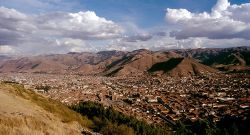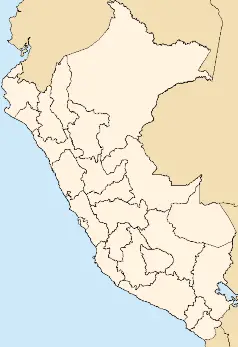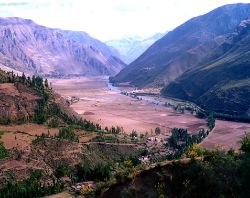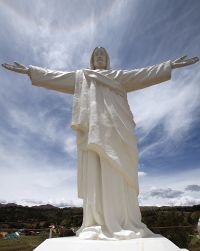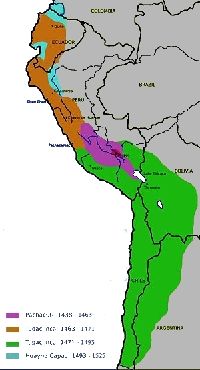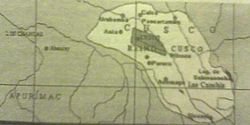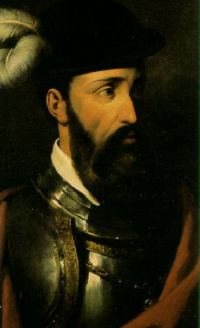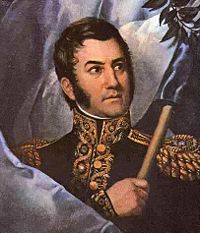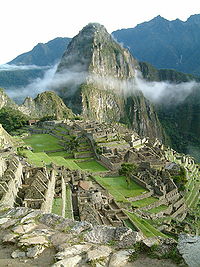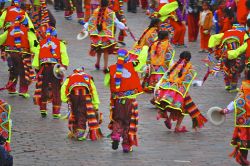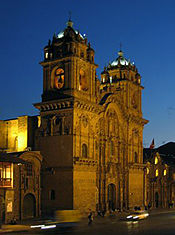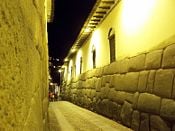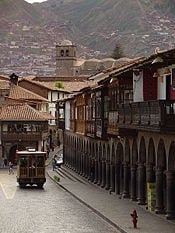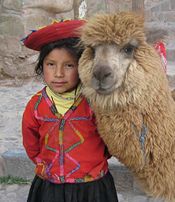Difference between revisions of "Cusco" - New World Encyclopedia
Mike Butler (talk | contribs) |
Rosie Tanabe (talk | contribs) |
||
| (112 intermediate revisions by 7 users not shown) | |||
| Line 1: | Line 1: | ||
| − | {{ | + | {{Images OK}}{{Submitted}}{{Approved}}{{copyedited}} |
| − | {{ | + | {{Infobox Settlement |
| − | + | |name = Cusco | |
| − | | | + | |official_name = Cusco / Cuzco (Spanish)<br /> Qosqo ([[Quechua languages|Quechua]]) |
| − | | | ||
| − | | | ||
|nickname = La Ciudad Imperial (The Imperial City) | |nickname = La Ciudad Imperial (The Imperial City) | ||
| − | |motto = | + | |motto = |
| − | |image_skyline = | + | |image_skyline = Cusco-c01.jpg |
| − | + | |image_caption = View of Cusco from Sacsayhuaman | |
| − | |image_caption = | ||
|image_flag = Flag_of_Cusco.svg | |image_flag = Flag_of_Cusco.svg | ||
| − | |||
|flag_size = 100px | |flag_size = 100px | ||
| + | |image_seal = COA_of_Cuzco.jpg | ||
|seal_size = 80px | |seal_size = 80px | ||
| − | |||
| − | |||
| − | |||
|image_map = | |image_map = | ||
| − | |mapsize = | + | |mapsize = |
| − | |map_caption = | + | |map_caption = |
| − | |pushpin_map = Peru | + | |pushpin_map = Peru |
|pushpin_label_position = <!-- the position of the pushpin label: left, right, top, bottom, none —> | |pushpin_label_position = <!-- the position of the pushpin label: left, right, top, bottom, none —> | ||
| + | |coordinates_region = PE | ||
|subdivision_type = Country | |subdivision_type = Country | ||
| − | |subdivision_name = | + | |subdivision_name = {{flagcountry|Peru}} |
| − | |subdivision_type1 = Region | + | |subdivision_type1 = [[Administrative divisions of Peru|Region]] |
|subdivision_name1 = [[Cusco Region|Cusco]] | |subdivision_name1 = [[Cusco Region|Cusco]] | ||
| − | |subdivision_type2 = Province | + | |subdivision_type2 = [[Provinces of Peru|Province]] |
|subdivision_name2 = [[Cusco Province|Cusco]] | |subdivision_name2 = [[Cusco Province|Cusco]] | ||
| − | + | |government_type = City | |
| − | |||
| − | |||
| − | |||
| − | |government_type = | ||
|leader_title = Mayor | |leader_title = Mayor | ||
| − | |leader_name = | + | |leader_name = Luis Florez |
|established_title = Founded | |established_title = Founded | ||
| − | |established_date = | + | |established_date = 1100 |
|established_title2 = <!-- Incorporated (town) —> | |established_title2 = <!-- Incorporated (town) —> | ||
| − | |established_date2 = | + | |established_date2 = |
|established_title3 = <!-- Incorporated (city) —> | |established_title3 = <!-- Incorporated (city) —> | ||
| − | |established_date3 = | + | |established_date3 = |
| − | |area_magnitude = | + | |area_magnitude = |
|unit_pref = <!--Enter: Imperial, if Imperial (metric) is desired—> | |unit_pref = <!--Enter: Imperial, if Imperial (metric) is desired—> | ||
|area_footnotes = | |area_footnotes = | ||
| − | |area_total_km2 | + | |area_total_km2 = 70015 |
| − | + | |population_as_of = | |
| − | + | |population_footnotes = 2007 | |
| − | + | |population_note = | |
| − | |||
| − | |||
| − | |||
| − | |||
| − | |||
| − | |||
| − | |||
| − | |population_as_of = | ||
| − | |population_footnotes = | ||
| − | |population_note = | ||
|settlement_type = <!--For Town or Village (Leave blank for the default City)—> | |settlement_type = <!--For Town or Village (Leave blank for the default City)—> | ||
| − | |population_total = | + | |population_total = 358935 |
| − | |population_density_km2 | + | |population_density_km2 = auto |
| − | |||
| − | |||
| − | |||
| − | |||
| − | |||
| − | |||
| − | |||
|timezone = PET | |timezone = PET | ||
|utc_offset = -5 | |utc_offset = -5 | ||
| Line 73: | Line 47: | ||
|utc_offset_DST = -5 | |utc_offset_DST = -5 | ||
|latd = 13 <!-- degrees —> | |latd = 13 <!-- degrees —> | ||
| − | |latm = | + | |latm = 31 <!-- minutes —> |
| − | |||
|latNS = S <!-- South —> | |latNS = S <!-- South —> | ||
|longd = 71 <!-- degrees —> | |longd = 71 <!-- degrees —> | ||
|longm = 58 <!-- minutes —> | |longm = 58 <!-- minutes —> | ||
| − | |||
|longEW = W <!-- West —> | |longEW = W <!-- West —> | ||
| − | |elevation_footnotes = <!--for references: use | + | |coordinates_display = inline,title |
| − | |elevation_m = | + | |elevation_footnotes = <!--for references: use tags—> |
| − | |elevation_ft = | + | |elevation_m = 3399 |
| + | |elevation_ft = | ||
|postal_code_type = <!-- enter ZIP code, Postcode, Post code, Postal code... —> | |postal_code_type = <!-- enter ZIP code, Postcode, Post code, Postal code... —> | ||
|postal_code = | |postal_code = | ||
|area_code = 84 | |area_code = 84 | ||
| − | |||
|footnotes = | |footnotes = | ||
| + | |website = [http://www.municusco.gob.pe/ www.municusco.gob.pe] | ||
}} | }} | ||
| − | | | + | |
| − | |{{Infobox World Heritage Site | + | '''Cusco''' (also spelled '''Cuzco,''' and in the [[Quechua]] language as '''Qusqu''' {{IPA2|'qos.qo}}) is a city in southeastern [[Peru]] near the [[Sacred Valley]] in the [[Andes]] mountain range, southeast of the [[Inca]]n city of [[Machu Picchu]]. Cusco was the capital of the extensive [[Inca Empire]], and continues as a favorite destination for tourists seeking to explore Inca [[relic]]s. |
| + | |||
| + | One of the oldest continuously inhabited cities in the [[Western Hemisphere]], it has a complex [[history]], woven with significant events and legends. An urban center created by the Incas, with distinct religious and administrative functions, it was preserved by the conquering [[Spanish Conquistadors|Spaniards]], who built [[Baroque architecture|Baroque]] [[church]]es and [[palace]]s over the ruins of the ancient city, leaving its foundation intact. Much of its highly crafted early stone architecture is preserved in the foundations and lower stories of Spanish colonial structures. | ||
| + | |||
| + | The [[Inca Civilization]] incorporated, and in many cases perfected, many of the cultural techniques of the [[civilization]]s that preceded it. There are many examples of original Inca [[architecture]] and [[engineering]] that have outlasted later Spanish colonial structures. In this regard, the rich Inca heritage can still be observed throughout Cusco and in the extensive stone [[road]]s that united the city with the four cardinal points of the Inca Empire. | ||
| + | {{toc}} | ||
| + | Cusco, the major cultural and population center of the Incan civilization, stands today as both a reminder of previous cultures and a modern functioning city. Recognized as an historical treasure, the entire city was designated a [[UNESCO]] [[World Heritage Site]] in 1983. The living record that is Cusco serves as a reminder of an ancient [[civilization]] that displayed remarkable technical achievements in harmony with the [[natural environment]]. | ||
| + | [[Image:Urubamba_valley1.jpg|thumb|250px|left|Cusco is situated near the Sacred Valley of the Incas.]] | ||
| + | {{Infobox World Heritage Site | ||
|WHS = City of Cuzco | |WHS = City of Cuzco | ||
|Image = [[Image:Koricancha.jpg|250px|Coricancha temple and Church of Santo Domingo]] | |Image = [[Image:Koricancha.jpg|250px|Coricancha temple and Church of Santo Domingo]] | ||
| Line 102: | Line 83: | ||
|Link = http://whc.unesco.org/en/list/273 | |Link = http://whc.unesco.org/en/list/273 | ||
}} | }} | ||
| − | + | ==Etymology== | |
| − | ''' | + | The name ''Cusco'', which comes from a Quechua word ''(Qosqo)'' meaning ''navel'' or ''center'' |
| + | "''Qosqo''" was transliterated into [[Spanish language|Spanish]] as "''Cu'''s'''co''."<ref>Ioannem Ianssonium, [http://commons.wikimedia.org/wiki/Image:Mapa_Per%C3%BA_Ioannem_Ianssonium.JPG ''Mapa del Perú,''] Wikipedia Commons. Retrieved September 19, 2008. </ref> On maps from the nineteenth century (as early as 1810<ref>John Pinkerton, "Peru" ''World Atlas'' (London: Cadell and Davies, 1910).</ref>) and through the mid-twentieth century, the name appears as "Cu'''z'''co," although since then in Peruvian cartography (in Spanish) the name has returned to the original transliteration: ''Cusco''. | ||
==Geography== | ==Geography== | ||
| − | + | The city is located in Peru's southern highlands, at the west end of the Huatanay valley, which is a basin extending 20 miles (30km) east. High in the [[Andes Mountains]], Cusco's average elevation is around 11,150 feet (3,400 meters). The Huatanay, Huancaro, and Chunchullmayo rivers, tributaries of the Vilcanota, provide [[water]]. | |
| − | |||
| − | |||
| − | |||
| − | The city is located in | ||
| − | Cusco's temperature is relatively consistent year-round, with average maximum daytime temperatures of 70°F (21°C), with July minimums of 30°F (-1°C). Usually, it is cold at night and the temperature increases considerably until noon. Frost is rare. The | + | Cusco's [[temperature]] is relatively consistent year-round, with average maximum daytime temperatures of 70°F (21°C), with July minimums of 30°F (-1°C). Usually, it is cold at night and the temperature increases considerably until noon. Frost is rare. The [[rain]]y season goes from November to March, and the dry season goes from April to October. The average annual precipitation is 32 inches (812 mm). |
| − | Cusco was found in 2006 to be the spot on Earth with the highest [[ultraviolet]] light level.<ref> | + | Cusco was found in 2006 to be the spot on Earth with the highest [[ultraviolet]] light level.<ref>Ben J. Liley and Richard L. McKenzie, "Where on Earth has the highest UV?" ''UV Radiation and its Effects: An Update'' (Hamilton, NZ: NIWA Science, 2006).</ref> |
| − | + | [[Image:CristoBlancoCuzco.jpg|200px|left|thumb|Cristo Blanco overlooks the city.]] | |
| − | + | Under the [[Incas]], facades of massive [[stone]] bordered Cusco's town squares. Colonial urban planners built new structures on Inca foundations, and superimposed the [[Plaza de Armas]] on the Inca square, and preserved the Inca street grid. Numerous narrow [[flagstone]] streets run between walls of Inca masonry. Baroque and Metis churches with cupolas border the urban squares, while further from the center, neighborhoods comprise low residential buildings with whitewashed facades. | |
| − | |||
| − | |||
==History== | ==History== | ||
| − | + | [[Image:Expansion Imperio Inca-1-.JPG|thumb|right|200px|Inca expansion (1438–1527).]] | |
| − | + | [[Image:Kigdomofcuscomap.JPG|thumb|250px|Map of the Kingdom of Cusco.]] | |
| − | [[Image:Expansion Imperio Inca-1-.JPG|thumb|right| | + | Peruvian territory was inhabited at approximately 11,000 years B.C.E. The oldest known complex society in Peru, the [[Norte Chico civilization]], flourished along the coast of the [[Pacific Ocean]] between 3000 and 1800 B.C.E.<ref>Jonathan Haas, Winifred Creamer, and Alvaro Ruiz, "Dating the Late Archaic occupation of the Norte Chico region in Peru," ''Nature'' 432 (7020): 1021.</ref> These early developments were followed by [[archaeology|archaeological]] cultures such as [[Chavín culture|Chavin]], [[Paracas culture|Paracas]], [[Mochica Culture|Mochica]], [[Nazca culture|Nazca]], [[Huari Culture|Wari]], and [[Chimú culture|Chimu]]. |
| − | [[Image: | ||
| − | |||
| − | Peruvian territory was inhabited at approximately 11,000 years | ||
| − | The Killke occupied the Cusco region from 900 to 1200 | + | The Killke occupied the Cusco region from 900 to 1200 C.E. Archaeologists discovered, on March 13, 2008, the ruins of an ancient temple, roadway and irrigation systems at [[Sacsayhuaman]], a famed fortress overlooking the Inca capital of Cuzco. Previous [[carbon-14 dating]] of Sacsayhuaman revealed that the Killke culture constructed the fortress in the 1100s. In 2007, excavations uncovered another temple on the edge of the fortress, indicating religious as well as military use.<ref>Andrew Whalen, Pre-Inca Temple Discovered in Peru, ''Seattle Times'', March 15, 2008.</ref> |
===Inca city state=== | ===Inca city state=== | ||
| − | The Inca people began as a tribe in the | + | The Inca people began as a tribe in the Cusco area around the 12th century C.E. Under the leadership of [[Manco Capac]], they formed the small city-state of Cuzco ([[Quechua]] ''Qosqo''). Manco Capac ruled for about 40 years, establishing a code of laws, and is thought to have abolished [[human sacrifice]]. He is thought to have reigned until about 1230, though some put his death in 1107. |
| − | In 1438, under the command of the ninth [[Sapa Inca]] (paramount leader) [[Pachacutec]] (1438-1471/1472), whose name literally meant "world-shaker" | + | In 1438, under the command of the ninth [[Sapa Inca]] (paramount leader) [[Pachacutec]] (1438-1471/1472), whose name literally meant "world-shaker," the Incas began a far-reaching expansion, extending from the northern border of present-day [[Ecuador]] to the center of present-day [[Chile]]. Pachacutec reorganized the kingdom of Cusco into an empire, the Tahuantinsuyu, a federalist system which consisted of a central government with the Inca at its head and four provincial governments with strong leaders: [[Chinchasuyu]] in the northwest, [[Antisuyu]] (northeast), [[Contisuyu]] (southwest), and [[Collasuyu]] (southeast). |
| − | Pachacuti is also | + | Pachacuti is also believed to have built [[Machu Picchu]] on a [[mountain]] ridge 50 miles (80 km) northwest of Cusco, around 1460, as a family home, a retreat, or a fortress. The intended purpose of the city has been a matter of debate, particularly since the [[Inca]] kept no written records. |
| − | As the capital of the [[Inca Empire]], many believe that the city of Cusco was planned to be shaped like a [[puma]]. The city had two sectors: | + | As the capital of the [[Inca Empire]], many believe that the city of Cusco was planned to be shaped like a [[puma]]. The city had two sectors: The ''urin'' and ''hanan,'' which were further divided to each encompass two of the four provinces. A [[road]] led from each of these quarters to the corresponding quarter of the empire. Each local leader was required to build a house in the city and live part of the year in Cusco, but only in the quarter of Cusco that corresponded to the quarter of the empire in which he had territory. |
| − | After [[Pachacuti]], when an [[ | + | After [[Pachacuti]], when an [[Inca]] died his title went to one son and his property was given to a corporation controlled by his other relatives; a process called split inheritance. This meant that each title holder had to build a new house and add new lands to the empire, in order to own the land his family needed to maintain after his death. |
| − | According to Inca legend, the city was built by [[Pachacuti]], but archaeological evidence points to a slower, more organic growth of the city beginning before Pachacuti. There was however a city plan, and two rivers were channeled around the city. | + | According to Inca legend, the city was built by [[Pachacuti]], but archaeological evidence points to a slower, more organic growth of the city beginning before Pachacuti. There was, however, a city plan, and two rivers were channeled around the city. |
| − | The city fell to the sphere of [[Huáscar]], who was Sapa Inca from 1527 to 1532, after the death of [[Huayna Capac]] in 1527. It was captured by the generals of [[Atahualpa]] in April 1532 in the [[Battle of Quipaipan]], and 19 months later by the Spaniards | + | The city fell to the sphere of [[Huáscar]], who was Sapa Inca from 1527 to 1532, after the death of [[Huayna Capac]] in 1527. It was captured by the generals of [[Atahualpa]] in April 1532, in the [[Battle of Quipaipan]], and 19 months later by the Spaniards. |
===Spanish conquest=== | ===Spanish conquest=== | ||
| − | [[Image:Francisco Pizarro.jpeg|thumb| | + | [[Image:Francisco Pizarro.jpeg|thumb|200px|Francisco Pizarro, who reported to the King of Spain; "We can assure your majesty that it is so beautiful and has such fine buildings that it would even be remarkable in Spain."]] |
| − | Spanish [[conquistador]] [[Francisco Pizarro]] | + | [[Spain|Spanish]] [[conquistador]] [[Francisco Pizarro]] and his brothers, who were attracted by reports of a rich and fabulous kingdom, arrived in the country which they called Peru in 1532. At that time, the [[Inca Empire]] was preoccupied by a five-year [[civil war]] between two princes, [[Huáscar]] and [[Atahualpa]]. On November 16, 1532, while the natives were celebrating in [[Cajamarca (city)|Cajamarca]], the Spanish captured the Inca Atahualpa by surprise during the [[Battle of Cajamarca]]. When Huascar was killed, the Spanish tried and convicted Atahualpa of the murder, executing him by strangulation. |
| − | The first [[Spanish Empire|Spaniards]] arrived in Cusco on November 15, 1533, and [[Pizarro]] who officially discovered the city on March 23, 1534, named it the "Very noble and great city of Cusco" | + | The first [[Spanish Empire|Spaniards]] arrived in Cusco on November 15, 1533, and [[Pizarro]] who officially discovered the city on March 23, 1534, named it the "Very noble and great city of Cusco." Pizarro set up government there, but moved the capital to [[Lima]] on the coast in 1535. Political and administrative institutions were organized. The new rulers instituted an [[encomienda|''encomienda'' system]], by which the Spanish extracted tribute from the local population, part of which was forwarded to [[Seville]] in return for converting the natives to [[Christianity]]. Title to the land itself remained with the king of [[Spain]]. |
| − | + | Under colonial rule, [[agriculture]], cattle raising, [[mining]], and trade with [[Habsburg]] [[Spain]] made Cusco prosperous. The Spanish undertook the construction of a new city on the foundations of the old Inca city, replacing temples with churches and palaces with mansions for the conquerors. These included the [[Cathedral of Santo Domingo (Cusco)|cathedral]], [[National University of San Antonio Abad in Cusco|university]] and [[Archbishopric]]. | |
| − | + | Cusco was hit by an [[earthquake]] in 1650. The rebuilding that followed produced prolific artistic masonry, [[painting]], [[sculpture]], [[jewelry]], and ornamental woodworking. | |
| − | + | ===Independence=== | |
| + | [[Image:Smartin.JPG|thumb|200px|left|Don Jose de San Martin, who proclaimed the independence of Peru.]] | ||
| + | The Viceroyalty of Peru became the richest and most powerful Spanish Viceroyalty of America in the eighteenth century. However, [[mining]] and [[textile]] production declined, and an economic crisis favored an indigenous rebellion that erupted from 1780 to 1781, led by [[Tupac Amaru II]] (1742-1981). A [[Creole]] rebellion in the city of Huánuco arose in 1812, and a rebellion in Cusco arose between 1814 and 1816. The Viceroyalty of Peru succumbed to campaigns of [[Simón Bolivar]] (1783-1830) and [[Jose de San Martin]] (1778-1850), who proclaimed the independence of Peru in Lima on July 28, 1821. | ||
| − | + | In 1911, American historian [[Hiram Bingham]] brought [[Machu Picchu]] to worldwide attention. Since then, Machu Picchu has become an important tourist attraction. Further investigations revealed that the site may have been discovered and plundered several years previously, in 1867, by a German businessman, Augusto Berns. | |
| − | + | ||
| + | An [[earthquake]], in May 1950, destroyed the Dominican Priory and Church of Santo Domingo. However, the city's Inca [[architecture]] withstood the earthquake, which exposed the granite walls of the Coricancha, and other walls throughout the city. | ||
| − | + | [[UNESCO]] placed Cusco on the [[World Heritage Site|World Cultural Heritage List]] in 1983. | |
==Government== | ==Government== | ||
| − | + | Peru is a constitutional republic. The president is both the chief of state and head of government, and is elected by popular vote for a five year term, being eligible for a non-consecutive re-election. The unicameral Congress of the Republic of Peru has 120 members elected by popular vote to serve five year terms. | |
| − | Peru is a constitutional republic. The president is both the chief of state and head of government, and is elected by popular vote for a five | ||
| − | Cusco is the capital of the Cusco region, and of the Cusco province, one of the region's 13 provinces. The province is divided into eight districts, each of which is headed by a mayor | + | Cusco is the capital of the Cusco region, and of the Cusco province, one of the region's 13 provinces. The province is divided into eight districts, each of which is headed by a mayor. |
==Economy== | ==Economy== | ||
| − | Abundant mineral resources are found in [[Peru]]'s mountainous areas, and coastal waters provide excellent fishing grounds. However, | + | [[File:Peru Machu Picchu Sunrise.jpg|200px|thumb|right|Machu Picchu, which is located about 62 miles to the northwest of Cusco, draws many tourists to the area.]] |
| − | + | Abundant [[mineral]] resources are found in [[Peru]]'s mountainous areas, and coastal waters provide excellent [[fishing]] grounds. However, over-dependence on minerals and [[metal]]s subjects the economy to fluctuations in world prices, and a lack of infrastructure deters trade and investment. Although the Peruvian economy grew by more than four percent each year during the period 2002-2006, under-employment and [[poverty]] have stayed persistently high. Peru's per capita GDP was estimated at $7800 in 2007. | |
| − | |||
| − | |||
| − | |||
| − | |||
| − | |||
| − | |||
| − | |||
| − | |||
| − | |||
| − | |||
| − | |||
| − | |||
| − | |||
| − | |||
| − | |||
| − | |||
| − | |||
| − | |||
| − | + | As headquarters to the Inca Empire, Cusco was an important [[agriculture|agricultural]] region and a natural reserve for thousands of native Peruvian [[species]], including hundreds of [[potato]] varieties. The surrounding Huatanay Valley is strong in agriculture, including [[maize|corn]], [[barley]], [[quinoa]], [[tea]] and [[coffee]], and [[gold]] mining. | |
| − | + | As the [[tourism]] mecca of [[South America]], Cusco attracts more than 600,000 international visitors each year. [[Inca]] ruins in the [[Sacred Valley]], as well as traditional farming methods and the numerous varieties of potato and corn, and protein rich cereals and grains such as [[kiwicha]], [[quinua]], and [[tarwi]], attract a wide range of tourists. | |
| − | + | Public transport is provided by taxis and “combis,” or small buses. There is both a bus service and a train service to the Sacred Valley. The “Inca Trail” foot track is promoted as the best way to get to know [[Machu Picchu]], which is approximately 62 miles to the northwest of Cusco. The city is served by [[Alejandro Velasco Astete International Airport]]. | |
| − | |||
| − | |||
| − | |||
| − | |||
| − | |||
| − | |||
| − | + | ==Demographics and culture== | |
| + | The [[city]] had a [[population]] of 348,935 in 2008, which is triple the figure of 20 years earlier. Amerindians made up 45 percent of the population in 2003, ''mestizo'' (mixed Amerindian and white) 37 percent, white 15 percent, black, Japanese, Chinese, and other three percent. | ||
| − | + | [[Spanish language|Spanish]] and [[Quechua]] are the official [[language]]s, while Aymara and a large number of minor Amazonian languages are spoken in Peru. [[Roman Catholic]]s make up 81 percent of the population, [[Seventh Day Adventist]] 1.4 percent, other [[Christian]] 0.7 percent, other 0.6 percent, while 16.3 percent had either an unspecified or no [[religion]] in 2003. The [[National University of San Antonio Abad del Cuzco]], which was founded 1598, is the city's chief tertiary [[education]] provider. | |
| − | + | At Cusco's numerous restaurants, visitors can taste many spices and agricultural products, mostly organic, grown in traditional ways, frequently using ancient techniques such as the "Chaquitaclla" (foot plough). | |
| − | + | Cusco's main stadium, [[Estadio Garcilaso de la Vega]], is home to one of the country's most successful soccer clubs, [[Cienciano]]. Cusco's local team has won several international competitions in South America. | |
| − | |||
| − | + | ===Places of interest=== | |
| − | + | Although the original [[Inca]] city was sacked in 1535, Inca masonry is widespread. Buildings of interest include: | |
| + | * [[Machu Picchu]], the most familiar symbol of the Inca Empire, and one of the New Seven Wonders of the World, which can be reached on foot by a [[Inca road system|Inca trail]] or by train. | ||
| + | * [[Ollantaytambo]], which is a town and an [[Inca]] archaeological site 60 km northwest of Cusco at an altitude of 9160 feet (2792 meters). Ollantaytambo was the royal estate of Emperor [[Pachacuti]], and at the time of the [[Spanish conquest of Peru]] it served as a stronghold for [[Manco Inca Yupanqui]], leader of the Inca resistance. | ||
| + | [[Image:Cusco parade.jpg|250px|thumb|Parade through Plaza De Armas.]] | ||
| + | * [[Sacsayhuamán]], an [[Inca]] walled complex near the old city of Cusco, was built at an altitude of 12,142 feet (3,701 meters). Some believe the walls were a form of fortification, while others believe it was only used to form the head of the [[Cougar|Puma]] that Sacsayhuamán along with Cuzco form when seen from above. It is the most common starting points for the three-day, four-night hike known as the Inca Trail. | ||
| + | * The ''Camino Real,'' part of the Inca road system, passes through Cusco. With a length of 3230 miles (5200 km), it began in [[Quito]], [[Ecuador]], and ended in what is now Tucumán, [[Argentina]]. | ||
| + | * The Cathedral of Santo Domingo in Cusco, which is also known as Cusco Cathedral, is set on the main square of the city, the [[Plaza de Armas]]. It incorporates the foundations and some walls of the [[Inca]] [[Temple of the Sun]], and contained shrines to a variety of other gods. The Incas regarded it as a [[sacred]] site and was used as an [[astronomy|astronomical]] observatory. | ||
| + | ==Looking to the future== | ||
| + | The revelation of the old Inca site of [[Machu Picchu]] to the world in 1911 fired the public imagination, and set in motion an ever-increasing flow of curious visitors from around the world. Some visitors experience high spiritual energy there, while others regard the structures as evidence of advanced [[science|scientific]] knowledge. While Peru struggles with under-employment and poverty, Cusco’s famous buildings continue to attract a steady flow of 600,000 international visitors each year, which is a goldmine for the city's economy. | ||
==Gallery== | ==Gallery== | ||
| − | [[Image:Cuzco- | + | <center> |
| − | + | {| | |
| − | + | |+ | |
| − | Image:Gwalpaca.jpg|A girl with her Alpaca | + | |- |
| − | + | | valign="top"| | |
| − | + | [[Image:La_Compania_Cusco_.jpg|thumb|175px|''Iglesia de la Compañía,'' Cuzco]] | |
| − | + | | valign="top"| | |
| + | [[Image:Inca_Wall.jpg|175px|thumb|Inca Wall.]] | ||
| + | | valign="top"| | ||
| + | [[Image:Cuzco Décembre 2007 - Balcons.jpg|thumb|175px|The charm of Cusco reflected in its balconies.]] | ||
| + | | valign="top"| | ||
| + | [[Image:Gwalpaca.jpg|175px|thumb|A girl with her Alpaca.]] | ||
| + | |- | ||
| + | |} | ||
| + | </center> | ||
==Notes== | ==Notes== | ||
| − | < | + | <references/> |
| − | |||
| − | |||
| − | |||
| − | == | + | ==References== |
| − | * Bauer, Brian S | + | * Bauer, Brian S. ''The Sacred Landscape of the Inca: The Cusco Ceque System''. Austin: University of Texas Press, 1998. ISBN 978-0292708655 |
| − | * Burns, Kathryn | + | * Burns, Kathryn. ''Colonial Habits: Convents and the Spiritual Economy of Cuzco, Peru''. Durham, NC: Duke University Press, 1999. ISBN 978-0822322917 |
| − | * Frost, Peter, and Ben Box | + | * Frost, Peter, and Ben Box. ''Cusco & the Sacred Valley Handbook: The Travel Guide''. Bath: Footprint, 2001. ISBN 978-1903471074 |
| − | * McEwan, Gordon Francis | + | * McEwan, Gordon Francis. ''Pikillacta: The Wari Empire in Cuzco''. Iowa City: University of Iowa Press, 2005. ISBN 978-0877459316 |
| − | * Sallnow, Michael J | + | * Sallnow, Michael J. ''Pilgrims of the Andes: Regional Cults in Cusco''. Washington, D.C.: Smithsonian Institution Press, 1987. ISBN 978-0874748260 |
| − | * Walker, Charles | + | * Walker, Charles. ''Smoldering Ashes: Cuzco and the Creation of Republican Peru, 1780-1840''. Durham, NC: Duke University Press, 1999. ISBN 978-0822322610 |
| − | * Zuidema, R. Tom | + | * ''World Fact Book''. Peru. |
| − | ISBN | + | * Zuidema, R. Tom. ''Inca Civilization in Cuzco''. Austin: University of Texas Press, 1990. ISBN 978-0292738515 |
==External links== | ==External links== | ||
| − | + | All links retrieved January 12, 2024. | |
| − | |||
| − | |||
| − | |||
| − | |||
| − | |||
| − | |||
| − | + | *[http://maps.google.com/maps?q=Cusco+Peru&ie=UTF8&hl=en&cd=1&ll=-13.524097,-71.96208&spn=0.039389,0.05785&t=h&z=14&om=0 Cusco at Google Maps] | |
| + | *[http://whc.unesco.org/en/list/273 City of Cusco] UNESCO | ||
[[Category:Geography]] | [[Category:Geography]] | ||
[[Category:Cities]] | [[Category:Cities]] | ||
| + | [[Category:South America]] | ||
| + | [[Category:World Heritage Sites]] | ||
{{credit|Cusco|236500848|Kingdom_of_Cusco|216119857|}} | {{credit|Cusco|236500848|Kingdom_of_Cusco|216119857|}} | ||
Latest revision as of 06:49, 12 January 2024
| Cusco | |||
| Cusco / Cuzco (Spanish) Qosqo (Quechua) |
|||
| View of Cusco from Sacsayhuaman | |||
|
|||
| Nickname: La Ciudad Imperial (The Imperial City) | |||
| Coordinates: 13°31′S 71°58′W | |||
|---|---|---|---|
| Country | |||
| Region | Cusco | ||
| Province | Cusco | ||
| Founded | 1100 | ||
| Government | |||
| - Type | City | ||
| - Mayor | Luis Florez | ||
| Area | |||
| - Total | 70,015 km² (27,032.9 sq mi) | ||
| Elevation | 3,399 m (11,152 ft) | ||
| Population 2007 | |||
| - Total | 358,935 | ||
| - Density | 5.1/km² (13.3/sq mi) | ||
| Time zone | PET (UTC-5) | ||
| - Summer (DST) | PET (UTC-5) | ||
| Area code(s) | 84 | ||
| Website: www.municusco.gob.pe | |||
Cusco (also spelled Cuzco, and in the Quechua language as Qusqu IPA: ['qos.qo]) is a city in southeastern Peru near the Sacred Valley in the Andes mountain range, southeast of the Incan city of Machu Picchu. Cusco was the capital of the extensive Inca Empire, and continues as a favorite destination for tourists seeking to explore Inca relics.
One of the oldest continuously inhabited cities in the Western Hemisphere, it has a complex history, woven with significant events and legends. An urban center created by the Incas, with distinct religious and administrative functions, it was preserved by the conquering Spaniards, who built Baroque churches and palaces over the ruins of the ancient city, leaving its foundation intact. Much of its highly crafted early stone architecture is preserved in the foundations and lower stories of Spanish colonial structures.
The Inca Civilization incorporated, and in many cases perfected, many of the cultural techniques of the civilizations that preceded it. There are many examples of original Inca architecture and engineering that have outlasted later Spanish colonial structures. In this regard, the rich Inca heritage can still be observed throughout Cusco and in the extensive stone roads that united the city with the four cardinal points of the Inca Empire.
Cusco, the major cultural and population center of the Incan civilization, stands today as both a reminder of previous cultures and a modern functioning city. Recognized as an historical treasure, the entire city was designated a UNESCO World Heritage Site in 1983. The living record that is Cusco serves as a reminder of an ancient civilization that displayed remarkable technical achievements in harmony with the natural environment.
| City of Cuzco* | |
|---|---|
| UNESCO World Heritage Site | |
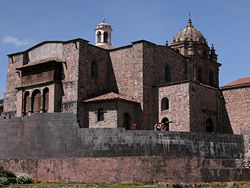
| |
| State Party | |
| Type | Cultural |
| Criteria | iii, iv |
| Reference | 273 |
| Region** | Latin America and the Caribbean |
| Inscription history | |
| Inscription | 1983 (7th Session) |
| * Name as inscribed on World Heritage List. ** Region as classified by UNESCO. | |
Etymology
The name Cusco, which comes from a Quechua word (Qosqo) meaning navel or center "Qosqo" was transliterated into Spanish as "Cusco."[1] On maps from the nineteenth century (as early as 1810[2]) and through the mid-twentieth century, the name appears as "Cuzco," although since then in Peruvian cartography (in Spanish) the name has returned to the original transliteration: Cusco.
Geography
The city is located in Peru's southern highlands, at the west end of the Huatanay valley, which is a basin extending 20 miles (30km) east. High in the Andes Mountains, Cusco's average elevation is around 11,150 feet (3,400 meters). The Huatanay, Huancaro, and Chunchullmayo rivers, tributaries of the Vilcanota, provide water.
Cusco's temperature is relatively consistent year-round, with average maximum daytime temperatures of 70°F (21°C), with July minimums of 30°F (-1°C). Usually, it is cold at night and the temperature increases considerably until noon. Frost is rare. The rainy season goes from November to March, and the dry season goes from April to October. The average annual precipitation is 32 inches (812 mm).
Cusco was found in 2006 to be the spot on Earth with the highest ultraviolet light level.[3]
Under the Incas, facades of massive stone bordered Cusco's town squares. Colonial urban planners built new structures on Inca foundations, and superimposed the Plaza de Armas on the Inca square, and preserved the Inca street grid. Numerous narrow flagstone streets run between walls of Inca masonry. Baroque and Metis churches with cupolas border the urban squares, while further from the center, neighborhoods comprise low residential buildings with whitewashed facades.
History
Peruvian territory was inhabited at approximately 11,000 years B.C.E. The oldest known complex society in Peru, the Norte Chico civilization, flourished along the coast of the Pacific Ocean between 3000 and 1800 B.C.E.[4] These early developments were followed by archaeological cultures such as Chavin, Paracas, Mochica, Nazca, Wari, and Chimu.
The Killke occupied the Cusco region from 900 to 1200 C.E. Archaeologists discovered, on March 13, 2008, the ruins of an ancient temple, roadway and irrigation systems at Sacsayhuaman, a famed fortress overlooking the Inca capital of Cuzco. Previous carbon-14 dating of Sacsayhuaman revealed that the Killke culture constructed the fortress in the 1100s. In 2007, excavations uncovered another temple on the edge of the fortress, indicating religious as well as military use.[5]
Inca city state
The Inca people began as a tribe in the Cusco area around the 12th century C.E. Under the leadership of Manco Capac, they formed the small city-state of Cuzco (Quechua Qosqo). Manco Capac ruled for about 40 years, establishing a code of laws, and is thought to have abolished human sacrifice. He is thought to have reigned until about 1230, though some put his death in 1107.
In 1438, under the command of the ninth Sapa Inca (paramount leader) Pachacutec (1438-1471/1472), whose name literally meant "world-shaker," the Incas began a far-reaching expansion, extending from the northern border of present-day Ecuador to the center of present-day Chile. Pachacutec reorganized the kingdom of Cusco into an empire, the Tahuantinsuyu, a federalist system which consisted of a central government with the Inca at its head and four provincial governments with strong leaders: Chinchasuyu in the northwest, Antisuyu (northeast), Contisuyu (southwest), and Collasuyu (southeast).
Pachacuti is also believed to have built Machu Picchu on a mountain ridge 50 miles (80 km) northwest of Cusco, around 1460, as a family home, a retreat, or a fortress. The intended purpose of the city has been a matter of debate, particularly since the Inca kept no written records.
As the capital of the Inca Empire, many believe that the city of Cusco was planned to be shaped like a puma. The city had two sectors: The urin and hanan, which were further divided to each encompass two of the four provinces. A road led from each of these quarters to the corresponding quarter of the empire. Each local leader was required to build a house in the city and live part of the year in Cusco, but only in the quarter of Cusco that corresponded to the quarter of the empire in which he had territory.
After Pachacuti, when an Inca died his title went to one son and his property was given to a corporation controlled by his other relatives; a process called split inheritance. This meant that each title holder had to build a new house and add new lands to the empire, in order to own the land his family needed to maintain after his death.
According to Inca legend, the city was built by Pachacuti, but archaeological evidence points to a slower, more organic growth of the city beginning before Pachacuti. There was, however, a city plan, and two rivers were channeled around the city.
The city fell to the sphere of Huáscar, who was Sapa Inca from 1527 to 1532, after the death of Huayna Capac in 1527. It was captured by the generals of Atahualpa in April 1532, in the Battle of Quipaipan, and 19 months later by the Spaniards.
Spanish conquest
Spanish conquistador Francisco Pizarro and his brothers, who were attracted by reports of a rich and fabulous kingdom, arrived in the country which they called Peru in 1532. At that time, the Inca Empire was preoccupied by a five-year civil war between two princes, Huáscar and Atahualpa. On November 16, 1532, while the natives were celebrating in Cajamarca, the Spanish captured the Inca Atahualpa by surprise during the Battle of Cajamarca. When Huascar was killed, the Spanish tried and convicted Atahualpa of the murder, executing him by strangulation.
The first Spaniards arrived in Cusco on November 15, 1533, and Pizarro who officially discovered the city on March 23, 1534, named it the "Very noble and great city of Cusco." Pizarro set up government there, but moved the capital to Lima on the coast in 1535. Political and administrative institutions were organized. The new rulers instituted an encomienda system, by which the Spanish extracted tribute from the local population, part of which was forwarded to Seville in return for converting the natives to Christianity. Title to the land itself remained with the king of Spain.
Under colonial rule, agriculture, cattle raising, mining, and trade with Habsburg Spain made Cusco prosperous. The Spanish undertook the construction of a new city on the foundations of the old Inca city, replacing temples with churches and palaces with mansions for the conquerors. These included the cathedral, university and Archbishopric.
Cusco was hit by an earthquake in 1650. The rebuilding that followed produced prolific artistic masonry, painting, sculpture, jewelry, and ornamental woodworking.
Independence
The Viceroyalty of Peru became the richest and most powerful Spanish Viceroyalty of America in the eighteenth century. However, mining and textile production declined, and an economic crisis favored an indigenous rebellion that erupted from 1780 to 1781, led by Tupac Amaru II (1742-1981). A Creole rebellion in the city of Huánuco arose in 1812, and a rebellion in Cusco arose between 1814 and 1816. The Viceroyalty of Peru succumbed to campaigns of Simón Bolivar (1783-1830) and Jose de San Martin (1778-1850), who proclaimed the independence of Peru in Lima on July 28, 1821.
In 1911, American historian Hiram Bingham brought Machu Picchu to worldwide attention. Since then, Machu Picchu has become an important tourist attraction. Further investigations revealed that the site may have been discovered and plundered several years previously, in 1867, by a German businessman, Augusto Berns.
An earthquake, in May 1950, destroyed the Dominican Priory and Church of Santo Domingo. However, the city's Inca architecture withstood the earthquake, which exposed the granite walls of the Coricancha, and other walls throughout the city.
UNESCO placed Cusco on the World Cultural Heritage List in 1983.
Government
Peru is a constitutional republic. The president is both the chief of state and head of government, and is elected by popular vote for a five year term, being eligible for a non-consecutive re-election. The unicameral Congress of the Republic of Peru has 120 members elected by popular vote to serve five year terms.
Cusco is the capital of the Cusco region, and of the Cusco province, one of the region's 13 provinces. The province is divided into eight districts, each of which is headed by a mayor.
Economy
Abundant mineral resources are found in Peru's mountainous areas, and coastal waters provide excellent fishing grounds. However, over-dependence on minerals and metals subjects the economy to fluctuations in world prices, and a lack of infrastructure deters trade and investment. Although the Peruvian economy grew by more than four percent each year during the period 2002-2006, under-employment and poverty have stayed persistently high. Peru's per capita GDP was estimated at $7800 in 2007.
As headquarters to the Inca Empire, Cusco was an important agricultural region and a natural reserve for thousands of native Peruvian species, including hundreds of potato varieties. The surrounding Huatanay Valley is strong in agriculture, including corn, barley, quinoa, tea and coffee, and gold mining.
As the tourism mecca of South America, Cusco attracts more than 600,000 international visitors each year. Inca ruins in the Sacred Valley, as well as traditional farming methods and the numerous varieties of potato and corn, and protein rich cereals and grains such as kiwicha, quinua, and tarwi, attract a wide range of tourists.
Public transport is provided by taxis and “combis,” or small buses. There is both a bus service and a train service to the Sacred Valley. The “Inca Trail” foot track is promoted as the best way to get to know Machu Picchu, which is approximately 62 miles to the northwest of Cusco. The city is served by Alejandro Velasco Astete International Airport.
Demographics and culture
The city had a population of 348,935 in 2008, which is triple the figure of 20 years earlier. Amerindians made up 45 percent of the population in 2003, mestizo (mixed Amerindian and white) 37 percent, white 15 percent, black, Japanese, Chinese, and other three percent.
Spanish and Quechua are the official languages, while Aymara and a large number of minor Amazonian languages are spoken in Peru. Roman Catholics make up 81 percent of the population, Seventh Day Adventist 1.4 percent, other Christian 0.7 percent, other 0.6 percent, while 16.3 percent had either an unspecified or no religion in 2003. The National University of San Antonio Abad del Cuzco, which was founded 1598, is the city's chief tertiary education provider.
At Cusco's numerous restaurants, visitors can taste many spices and agricultural products, mostly organic, grown in traditional ways, frequently using ancient techniques such as the "Chaquitaclla" (foot plough).
Cusco's main stadium, Estadio Garcilaso de la Vega, is home to one of the country's most successful soccer clubs, Cienciano. Cusco's local team has won several international competitions in South America.
Places of interest
Although the original Inca city was sacked in 1535, Inca masonry is widespread. Buildings of interest include:
- Machu Picchu, the most familiar symbol of the Inca Empire, and one of the New Seven Wonders of the World, which can be reached on foot by a Inca trail or by train.
- Ollantaytambo, which is a town and an Inca archaeological site 60 km northwest of Cusco at an altitude of 9160 feet (2792 meters). Ollantaytambo was the royal estate of Emperor Pachacuti, and at the time of the Spanish conquest of Peru it served as a stronghold for Manco Inca Yupanqui, leader of the Inca resistance.
- Sacsayhuamán, an Inca walled complex near the old city of Cusco, was built at an altitude of 12,142 feet (3,701 meters). Some believe the walls were a form of fortification, while others believe it was only used to form the head of the Puma that Sacsayhuamán along with Cuzco form when seen from above. It is the most common starting points for the three-day, four-night hike known as the Inca Trail.
- The Camino Real, part of the Inca road system, passes through Cusco. With a length of 3230 miles (5200 km), it began in Quito, Ecuador, and ended in what is now Tucumán, Argentina.
- The Cathedral of Santo Domingo in Cusco, which is also known as Cusco Cathedral, is set on the main square of the city, the Plaza de Armas. It incorporates the foundations and some walls of the Inca Temple of the Sun, and contained shrines to a variety of other gods. The Incas regarded it as a sacred site and was used as an astronomical observatory.
Looking to the future
The revelation of the old Inca site of Machu Picchu to the world in 1911 fired the public imagination, and set in motion an ever-increasing flow of curious visitors from around the world. Some visitors experience high spiritual energy there, while others regard the structures as evidence of advanced scientific knowledge. While Peru struggles with under-employment and poverty, Cusco’s famous buildings continue to attract a steady flow of 600,000 international visitors each year, which is a goldmine for the city's economy.
Gallery
Notes
- ↑ Ioannem Ianssonium, Mapa del Perú, Wikipedia Commons. Retrieved September 19, 2008.
- ↑ John Pinkerton, "Peru" World Atlas (London: Cadell and Davies, 1910).
- ↑ Ben J. Liley and Richard L. McKenzie, "Where on Earth has the highest UV?" UV Radiation and its Effects: An Update (Hamilton, NZ: NIWA Science, 2006).
- ↑ Jonathan Haas, Winifred Creamer, and Alvaro Ruiz, "Dating the Late Archaic occupation of the Norte Chico region in Peru," Nature 432 (7020): 1021.
- ↑ Andrew Whalen, Pre-Inca Temple Discovered in Peru, Seattle Times, March 15, 2008.
ReferencesISBN links support NWE through referral fees
- Bauer, Brian S. The Sacred Landscape of the Inca: The Cusco Ceque System. Austin: University of Texas Press, 1998. ISBN 978-0292708655
- Burns, Kathryn. Colonial Habits: Convents and the Spiritual Economy of Cuzco, Peru. Durham, NC: Duke University Press, 1999. ISBN 978-0822322917
- Frost, Peter, and Ben Box. Cusco & the Sacred Valley Handbook: The Travel Guide. Bath: Footprint, 2001. ISBN 978-1903471074
- McEwan, Gordon Francis. Pikillacta: The Wari Empire in Cuzco. Iowa City: University of Iowa Press, 2005. ISBN 978-0877459316
- Sallnow, Michael J. Pilgrims of the Andes: Regional Cults in Cusco. Washington, D.C.: Smithsonian Institution Press, 1987. ISBN 978-0874748260
- Walker, Charles. Smoldering Ashes: Cuzco and the Creation of Republican Peru, 1780-1840. Durham, NC: Duke University Press, 1999. ISBN 978-0822322610
- World Fact Book. Peru.
- Zuidema, R. Tom. Inca Civilization in Cuzco. Austin: University of Texas Press, 1990. ISBN 978-0292738515
External links
All links retrieved January 12, 2024.
Credits
New World Encyclopedia writers and editors rewrote and completed the Wikipedia article in accordance with New World Encyclopedia standards. This article abides by terms of the Creative Commons CC-by-sa 3.0 License (CC-by-sa), which may be used and disseminated with proper attribution. Credit is due under the terms of this license that can reference both the New World Encyclopedia contributors and the selfless volunteer contributors of the Wikimedia Foundation. To cite this article click here for a list of acceptable citing formats.The history of earlier contributions by wikipedians is accessible to researchers here:
The history of this article since it was imported to New World Encyclopedia:
Note: Some restrictions may apply to use of individual images which are separately licensed.
